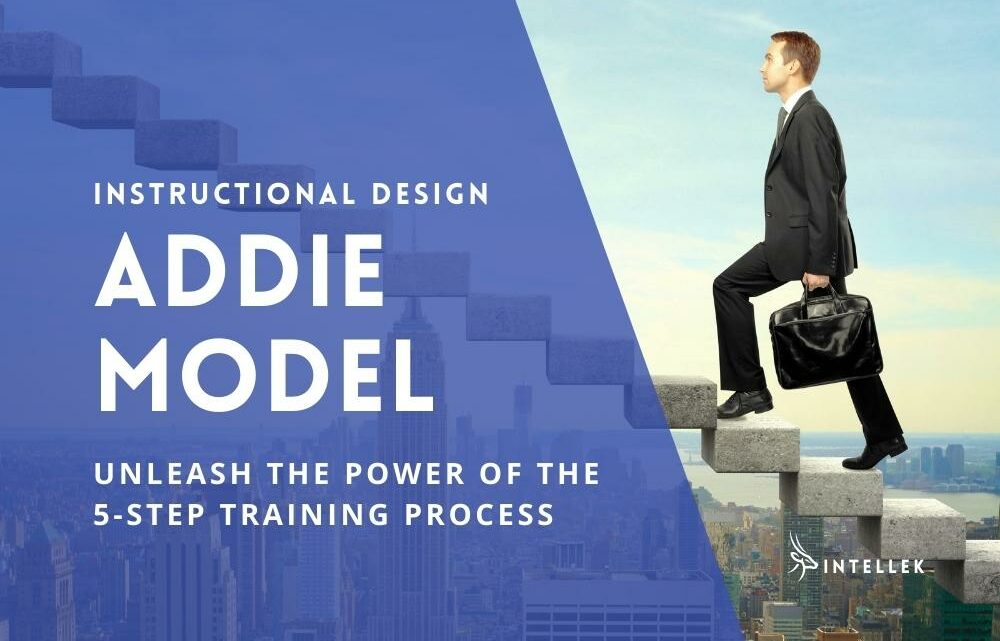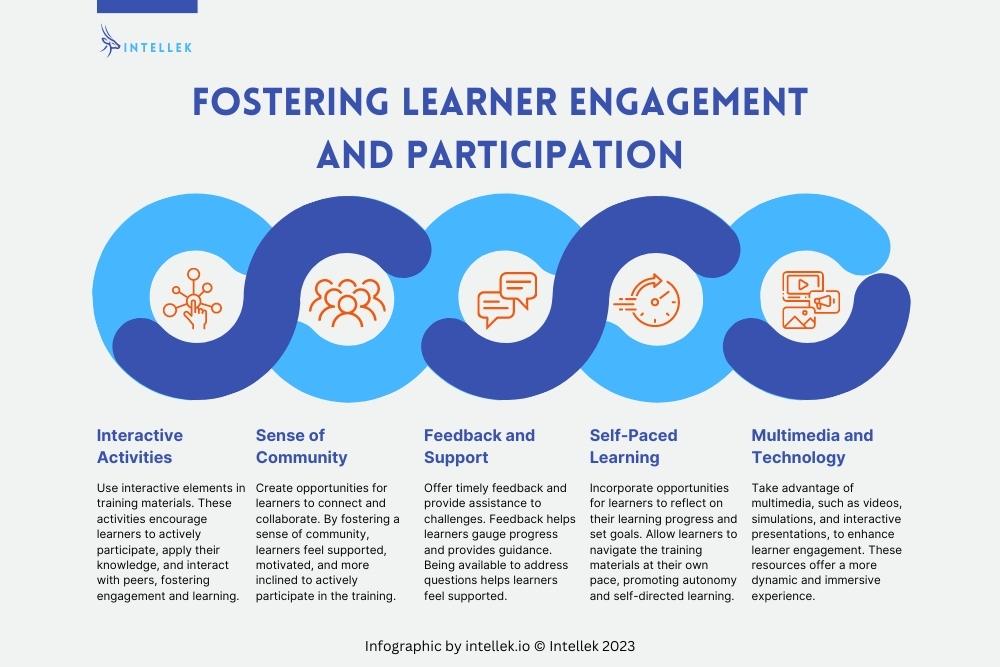
The field of instructional design relies on effective methodologies to develop impactful training courses. One such renowned model that has stood the test of time is the ADDIE Training Model.
In this article, we will explore the ins and outs of the ADDIE training model, delve into its methodologies, and uncover the core principles that make it a valuable tool for instructional designers. We will take an in-depth look at each stage of the ADDIE methodology, discussing the specific tasks and considerations involved. Additionally, training plan examples will be shared to illustrate the practical application of the ADDIE principles in training courses.
Whether you are an aspiring instructional designer or a seasoned professional, understanding the ADDIE model and its 5-step training process is crucial for creating effective learning experiences. So, let’s embark on this journey to discover the power and potential of the ADDIE model in instructional design.
IN THIS ARTICLE...
What are the 5 Steps of the ADDIE Model?
ADDIE is an acronym that represents the five essential stages of the development process:
- Analysis
- Design
- Develop
- Implement
- Evaluate
These stages must be followed in sequential order, with a strong emphasis on reflection and iteration.
Using ADDIE Training Model in Instructional Design
The ADDIE process serves as a guiding instructional design framework to create comprehensive and successful training programs. By understanding the principles and the ADDIE 5-step training process, instructional designers can craft engaging learning experiences that align with the needs of their target audience.
Step 1 Analysis: Understanding the Training Needs
Before embarking on the development of any training course, a solid foundation of understanding the training needs is essential. The analysis phase of the ADDIE model plays a pivotal role in this process. It involves conducting a thorough examination of the target audience, identifying learning objectives and desired outcomes, and gathering relevant data through a comprehensive needs assessment.
Analyze Your Target Audience
To create an effective training course, instructional designers must have a deep understanding of the target audience. This involves identifying their characteristics, such as knowledge levels, skill sets, job roles, and learning preferences. By conducting surveys, interviews, and observations, designers can gather valuable insights that help tailor the training to meet the specific needs of the audience.
Identify Learning Objectives and Outcomes
Clearly defined learning objectives serve as a roadmap for designing a training course. During the analysis phase, instructional designers collaborate with stakeholders and subject matter experts to identify the desired outcomes of the training. Learning objectives should be specific, measurable, achievable, relevant, and time-bound (SMART). They provide a clear focus and direction for the subsequent stages of the ADDIE process.
Gather Relevant Data and Conduct Needs Assessment
A needs assessment is a systematic process of gathering and analyzing data to determine the gaps between the current and desired performance levels. This data can be collected through surveys, focus groups, interviews, and review of existing materials. By examining the needs of the target audience, instructional designers can better align their ADDIE learning model with the requirements and bridge any performance gaps.
Examples of Analysis in Training Plan Scenarios
To understand the practical application of analysis in training plan scenarios, consider the following examples:
- A company wants to enhance the customer service skills of its call center representatives. Through analysis, the instructional designer identifies that the target audience consists of both new and experienced representatives, requiring tailored training modules for each group.
- A healthcare organization aims to improve compliance with safety protocols. Analysis reveals that different departments have varying levels of knowledge and adherence. As a result, the training plan includes specific modules for each department to address their unique needs.
The analysis phase of the ADDIE training process is crucial for understanding the learner’s needs. It involves conducting a thorough analysis of the target audience, identifying learning objectives, and gathering relevant data through a needs assessment. By undertaking this comprehensive analysis, instructional designers can lay a strong foundation for the subsequent stages of the ADDIE model, ensuring that the training course meets the specific needs of the learners.
Step 2 Design: Crafting Effective Training Courses
Once the analysis phase is complete, instructional designers move on to the design stage of the ADDIE model. This stage focuses on developing instructional strategies, selecting appropriate instructional methods and media, designing assessments and evaluations for measuring success, and creating an example instructional design using the ADDIE training model.
By paying attention to these crucial elements, instructional designers can create engaging, interactive, and impactful training courses that effectively meet the learning objectives of the target audience.
Develop Instructional Strategies and Content Outlines
In the design stage, instructional designers translate the identified learning objectives into actionable strategies and content outlines. They determine the overall structure and organization of the training course, breaking it down into modules, topics, and learning activities. By aligning the content with the learning objectives, instructional designers ensure that the training materials effectively deliver the desired outcomes.
Select Appropriate Instructional Methods and Media
With the rapid advancement of technology, e-learning has become an integral part of instructional design. During the design phase, instructional designers choose the most suitable instructional methods and media to engage learners and facilitate effective knowledge transfer. This can include interactive e-learning modules, videos, simulations, virtual reality, and other digital resources. The goal is to leverage technology to create an immersive and engaging learning experience.
Design Assessments and Measure Success
Assessments and evaluations play a vital role in determining the effectiveness of a training course. In the design stage, instructional designers create various assessments and evaluations that align with the learning objectives. These can include quizzes, tests, assignments, and practical exercises. To streamline the evaluation process, instructional designers often leverage Learning Management Systems (LMS) that enable easy administration and tracking of learner progress and performance.
Example Instructional Design Using the ADDIE Model
Let’s consider an example to illustrate instructional design using the ADDIE method…
Imagine an organization implementing a cybersecurity awareness training program. In the design phase, the instructional designer develops strategies to engage employees in understanding various cybersecurity threats and adopting best practices. They create content outlines that cover topics such as password security, phishing awareness, data protection, and safe browsing. To enhance interactivity, the designer incorporates e-learning modules that include real-life scenarios, interactive quizzes, and simulations.
Assessments are designed using the LMS, allowing learners to complete quizzes and evaluate their knowledge. The instructional design ensures learners gain the necessary knowledge and skills to protect sensitive information and mitigate cybersecurity risks.
Step 3 Develop: Creating Engaging Learning Materials
After the design phase, the development stage of the ADDIE training model comes into play. During this stage, instructional designers transform the design plans into tangible and engaging learning materials. This involves creating course materials based on the design phase, utilizing various media and technologies for interactive learning, collaborating with subject matter experts for content development, and ensuring alignment with learning objectives and the target audience.
By investing time and effort in the development stage, instructional designers can create engaging learning materials that align with the design plans and meet the specific needs of the target audience.
Create Course Materials Based on the Design Phase
In the development stage, instructional designers bring the design plans to life by creating the actual course materials. This includes developing instructional content, such as presentations, e-learning modules, videos, infographics, and written materials. The course materials are structured and organized according to the content outlines and instructional strategies outlined in the design phase.
Utilize Media and Technology for Interactive Learning
To enhance learner engagement and interactivity, instructional designers leverage a wide range of media and technologies. They incorporate multimedia elements such as images, videos, audio clips, and animations to make the learning experience more dynamic and engaging. Interactive elements like quizzes, simulations, branching scenarios, and gamified activities are utilized to promote active participation and reinforce learning.
Collaborate with Subject Matter Experts
Subject matter experts possess specialized knowledge and expertise in the topic being taught. During the development stage, instructional designers collaborate closely with these specialists to ensure the accuracy and relevance of the content. Subject matter experts provide valuable insights, review the training material and provide feedback to ensure that the instructional content aligns with the desired learning outcomes.
Ensuring Alignment with Learning Objectives
One of the key considerations in the development stage is ensuring alignment between the created learning materials and the identified learning objectives and target audience. Instructional designers review and revise the materials to ensure that they effectively address the identified training needs and are tailored to the characteristics and preferences of the learners. Regular checks are performed to ensure that the learning materials stay focused on the desired outcomes.
Step 4 Implement: Delivering the Training
In the ADDIE 5-step training process, the implementation stage is where the training is actually delivered to the learners. With a focus on online training and e-learning, this stage requires careful planning and execution to ensure effective delivery and maximum learner engagement. Key aspects of implementation include strategies for delivering effective online training sessions, facilitating learner engagement and participation, addressing challenges, and adapting the training as needed.
Strategies for Delivering Effective Training Sessions
- Utilize a Learning Management System (LMS): An LMS provides a centralized platform for organizing, delivering, and tracking online training. It allows learners to access course materials, complete assessments, and engage in discussions.
- Provide clear instructions and expectations: Clearly communicate the training schedule, expectations, and guidelines to the learners. This ensures that they understand how to navigate the online training environment and participate effectively.
- Offer synchronous and asynchronous learning opportunities: Balance live sessions, such as webinars or virtual classrooms, with self-paced modules and materials. This provides flexibility for learners and accommodates different learning preferences.
Facilitate Learner Engagement and Participation
One of the key aspects of successful online training is fostering learner engagement and active participation. By creating an interactive and dynamic learning environment, instructional designers can enhance the learning experience and promote learner involvement.
Here are some strategies for facilitating learner engagement and participation in online training:


- Design interactive activities: Incorporate interactive elements, such as quizzes, discussions, and collaborative projects, into the online training materials. These activities encourage learners to actively participate, apply their knowledge, and interact with their peers, fostering engagement and deeper learning.
- Foster a sense of community: Create opportunities for learners to connect and collaborate with each other. This can be achieved through discussion forums, chat features, or virtual group activities. By fostering a sense of community, learners feel supported, motivated, and more inclined to actively participate in the training.
- Provide regular feedback and support: Offer timely feedback on assessments and provide assistance when learners encounter challenges. Feedback helps learners gauge their progress and provides them with guidance for improvement. Additionally, being available to address questions and concerns helps learners feel supported and engaged throughout the training process.
- Encourage self-reflection and self-paced learning: Incorporate opportunities for learners to reflect on their learning progress and set goals. Allow learners to navigate the training materials at their own pace, promoting autonomy and self-directed learning. This flexibility accommodates different learning styles and preferences, fostering a more engaging learning experience.
- Utilize multimedia and interactive technologies: Take advantage of multimedia elements, such as videos, simulations, and interactive presentations, to enhance learner engagement. These media-rich resources offer a more dynamic and immersive learning experience, capturing learners’ attention and encouraging active participation.
By implementing these strategies, instructional designers can create an online training environment that encourages learner engagement and participation. By fostering collaboration, providing feedback and support, promoting self-reflection, and utilizing interactive technologies, learners become active participants in their own learning journey, resulting in a more effective and engaging online training experience.
Address Challenges and Adapt Training
To ensure a successful online training experience, it is important to focus on addressing challenges and adapting the training as needed. This can be done using the following approach:
Monitor learner progress: Regularly track learners’ progress using the Learning Management System (LMS) or other tracking tools. This enables you to identify any areas where learners may be facing challenges or struggling. By being aware of their progress, you can provide additional support or resources as needed to help them succeed.
Collect learner feedback: Gathering feedback from learners is valuable for improving the training materials, instructional methods, and overall learning experience. By actively seeking input from learners, you gain insights into their perspectives and can make necessary adjustments and improvements to enhance the effectiveness of the training.
Adapt to technological constraints: Online training may come with technological challenges that learners encounter. As an instructional designer, it is essential to be prepared to address these issues. Provide clear instructions on technical requirements and offer troubleshooting guidance to help learners overcome any technical hurdles they may face. By being proactive and responsive to technological constraints, you can ensure a smoother learning experience for your participants.
Step 5 Evaluate: Assessing Training Effectiveness
Evaluation is a critical phase in the ADDIE learning model as it allows instructional designers to assess the effectiveness of the training program and make data-driven improvements. This section explores the importance of evaluations in the ADDIE approach, the implementation of formative and summative evaluations, and the collection and analysis of data for continuous improvement.
Types of Evaluations and Their Importance in ADDIE
By implementing comprehensive evaluations, instructional designers can assess the impact and effectiveness of the training program, identify areas for improvement, and make data-driven decisions for continuous enhancement. The evaluation phase in the ADDIE training method ensures that the training program remains dynamic, responsive, and aligned with the evolving needs of the organization and its learners.
Evaluations in the ADDIE model serve two main purposes: to measure the achievement of learning objectives and to assess the overall effectiveness of the training program. There are two primary types of evaluations:
- Formative evaluation: This type of evaluation is conducted during the development process to provide ongoing feedback and identify areas for improvement. Formative evaluations help instructional designers make adjustments and refine the training program before its full implementation.
- Summative evaluation: Summative evaluations are conducted after the training program has been delivered to assess its overall effectiveness. These evaluations measure the extent to which the program achieved its learning objectives and whether it had a positive impact on participants’ knowledge, skills, and performance.
Both formative and summative evaluations play crucial roles in ensuring the effectiveness and continuous improvement of the training program.
Implementing Formative and Summative Evaluations
Formative and summative evaluations are implemented differently in the ADDIE methodology due to their distinct purposes and timing within the training development process.
How to use Formative Evaluations
During the development phase, instructional designers can implement formative evaluations through pilot testing and feedback sessions. This allows them to gather insights from a small group of learners and subject matter experts, identifying any gaps or areas that require improvement. Feedback from the pilot group helps refine the content, instructional strategies, and delivery methods.
How to use Summative Evaluations
Once the training program is fully implemented, summative evaluations assess its overall effectiveness. This can be done through various methods such as assessments, surveys, interviews, and observations. By measuring the achievement of learning objectives, evaluating participants’ performance, and capturing their feedback, instructional designers can gauge the impact of the training program on learners and the organization as a whole.
Collecting and analyzing data for continuous improvement To ensure continuous improvement, data collection and analysis are essential components of the evaluation process. Here are some key considerations:
- Use a combination of qualitative and quantitative methods: Gather both quantitative data, such as assessment scores and completion rates, and qualitative data, such as participant feedback and observations. This comprehensive approach provides a holistic understanding of the training program’s effectiveness.
- Analyze data for insights and trends: Examine the collected data to identify patterns, trends, and areas for improvement. Look for common challenges faced by learners, areas where learning objectives may not have been fully achieved, and opportunities for enhancing the training program.
- Incorporate feedback loops: Actively seek feedback from participants, trainers, and stakeholders to gain insights into their experiences and perceptions. Create mechanisms for ongoing feedback throughout the training program and use this feedback to inform continuous improvement efforts.
- Iteratively refine the training program: Based on the data and insights obtained from evaluations, make iterative improvements to the training program. Update content, modify instructional strategies, and adjust delivery methods to enhance the effectiveness and relevance of the program.
Reflection and Iteration: Continuous Improvement Loop
The ADDIE model emphasizes the importance of reflection and iteration as essential components for achieving continuous improvement in training courses. This section explores the role of reflection in the ADDIE method, iterating and refining training courses based on feedback, incorporating lessons learned into future iterations, and best practices for ongoing improvement.
Role of Reflection in ADDIE Methodology
Reflection plays a crucial role in the ADDIE method as it encourages instructional designers and stakeholders to pause and critically analyze the effectiveness of the training program. Through reflection, they can assess what worked well, what could be improved, and what lessons were learned during each phase of the ADDIE process. Reflection allows for a deeper understanding of the training program’s strengths and weaknesses, providing valuable insights for future iterations.
Iterating and Refining Training Courses
Feedback obtained through evaluations, participant surveys, and stakeholder input serves as a valuable source of information for iterating and refining training courses. Instructional designers should carefully analyze the feedback, identify common themes or areas for improvement, and make data-driven decisions to enhance the training program. This iterative process involves revising content, instructional strategies, assessments, and delivery methods based on the feedback received.
Incorporate Lessons Learned into Future Training
Lessons learned from previous training iterations should be carefully documented and incorporated into future versions of the training program. By systematically capturing and applying these lessons, instructional designers can avoid repeating past mistakes and build upon successful elements. This ensures that the training program evolves and improves over time, continuously meeting the changing needs of learners and the organization.
Best Practice for Ongoing Improvement
To facilitate ongoing improvement, instructional designers should consider the following best practices:
- Establish a culture of continuous improvement: Foster a mindset where reflection and iteration are embraced as standard practices. Encourage stakeholders, trainers, and learners to provide regular feedback and actively participate in the improvement process.
- Regularly revisit and update training materials: Keep training materials up to date with the latest industry trends, best practices, and technological advancements. This ensures that the training program remains relevant and effective in addressing learners’ needs.
- Seek diverse perspectives: Gather feedback from a variety of sources, including trainers, learners, subject matter experts, and stakeholders. Incorporating different perspectives helps identify blind spots and leads to more comprehensive improvements.
- Stay informed about emerging research and practices: Stay updated with the latest research, methodologies, and advancements in instructional design and training. This knowledge allows instructional designers to incorporate innovative approaches into their training courses and stay ahead of the curve.
- Regularly monitor and evaluate the impact of changes: Continuously monitor the impact of refinements made to the training program. Use evaluations, analytics, and participant feedback to assess the effectiveness of the changes and make further adjustments as necessary.
Advantages and Disadvantages of ADDIE Model
The ADDIE model is a systematic instructional design framework that helps create effective training and educational programs. Its key advantages include a structured, step-by-step approach that ensures thorough planning and evaluation. The model provides clear guidance for educators and trainers; this methodical approach allows for systematic problem-solving, helps identify learning needs, and creates targeted, learner-centered content that can be refined through continuous feedback. Its strength lies in its ability to ensure that learning materials are well-researched, carefully designed, and continuously improved based on evidence and learner performance, making it particularly valuable in fields like corporate training, educational curriculum development, and professional skills programs.
However, the ADDIE model is not without limitations. Its linear nature can make it less flexible in rapidly changing learning environments, potentially slowing down the development process. The model can be time-consuming and resource-intensive, especially in its comprehensive evaluation stages. Despite these drawbacks, organizations use this approach because it provides a reliable, comprehensive framework for creating high-quality educational experiences.
ADDIE Model Training Plan Example
The implementation stage of the ADDIE model involves delivering the training, with a focus on online training and e-learning. By employing effective strategies for online delivery, fostering learner engagement and participation, addressing challenges, and adapting the training as needed, instructional designers can ensure successful implementation.
The example below demonstrate the effectiveness of the ADDIE training model in facilitating engaging and impactful online learning experiences.
Implementing a Comprehensive Leadership Development Program in a Multinational Law Firm using the ADDIE Model…
Introduction: In response to the growing need for effective leadership development, a multinational law firm recognized the importance of implementing a comprehensive program to enhance leadership skills across the organization. Utilizing the ADDIE model, the firm successfully designed and implemented a blended approach that incorporated e-learning modules, virtual instructor-led sessions, and collaborative projects. The program aimed to equip leaders with the necessary competencies to navigate complex legal environments, drive innovation, and lead diverse teams effectively.
1) Analysis: The initial phase of the ADDIE model involved conducting a thorough analysis to understand the specific leadership needs within the law firm. Through extensive interviews, surveys, and data analysis, the firm identified key areas of focus, such as strategic thinking, effective communication, change management, and decision-making. This analysis helped tailor the program to address the unique challenges and requirements of leadership within a legal context.
2) Design: Based on the analysis findings, the instructional designers crafted a comprehensive design that encompassed various learning methods and strategies. E-learning modules were developed to provide foundational knowledge and skills, allowing leaders to access content at their convenience and pace. The modules incorporated interactive elements, case studies, and real-life legal scenarios to engage learners and promote practical application of concepts.
In addition to e-learning, virtual instructor-led sessions were organized to facilitate dynamic discussions, expert insights, and peer collaboration. These sessions allowed leaders from different office locations to connect and learn from each other’s experiences, promoting a sense of unity and shared learning.
To further enhance practical application and teamwork, collaborative projects were introduced. These projects required leaders to work together on real-world legal challenges, fostering collaboration, critical thinking, and problem-solving skills. The projects were designed to mirror the complexities and dynamics of the legal industry, providing an opportunity for leaders to apply their knowledge in a realistic context.
3) Development: During the development stage, instructional designers collaborated closely with subject matter experts, senior partners, and experienced practitioners within the law firm. This collaboration ensured that the content and examples were relevant, up-to-date, and aligned with the firm’s legal practices. Subject matter experts provided guidance on legal frameworks, case studies, and best practices, enriching the content with their expertise and practical insights.
4) Implementation: The implementation phase involved the deployment of the leadership development program to the targeted leaders within the multinational law firm. The firm leveraged its existing learning management system (LMS) to provide a centralized platform for accessing e-learning modules, scheduling virtual sessions, and facilitating collaboration on the projects.
To ensure successful implementation, a dedicated team of learning facilitators was assigned to support the participants throughout the program. Facilitators provided guidance, answered questions, facilitated discussions, and offered individualized coaching when needed. Regular check-ins and progress tracking were conducted to monitor participants’ engagement and provide timely feedback.
5) Evaluation: The implementation of the comprehensive leadership development program using the ADDIE process yielded significant positive outcomes for the multinational law firm. Leaders who participated in the program reported enhanced competencies in strategic thinking, communication, change management, and decision-making. They demonstrated an increased ability to navigate complex legal challenges, foster innovation, and effectively lead diverse teams.
Furthermore, the program fostered a culture of continuous learning and development within the law firm. Leaders who completed the program became champions of leadership development, sharing their knowledge and skills with their teams and promoting a growth mindset across the organization.
Conclusion: By successfully implementing a comprehensive leadership development program using the ADDIE principles, the multinational law firm was able to equip its leaders with the necessary skills and competencies to thrive in the legal industry. The blended approach, incorporating e-learning modules, virtual instructor-led sessions, and collaborative projects, proved to be effective in enhancing leadership skills and promoting a culture of continuous learning. This case study exemplifies the power of the ADDIE model in designing and implementing impactful training programs tailored to the specific needs of multinational organizations in complex professional domains.
Embrace the Power of ADDIE for Impactful Training Programs
The ADDIE training model, with its five-step training process, has proven to be an effective and reliable framework for instructional designers in creating impactful training programs. From analysis to evaluation, each stage of the ADDIE model provides a structured approach that emphasizes reflection and iteration, ensuring continuous improvement and alignment with learner needs.
By utilizing the ADDIE learning model, instructional designers can systematically assess the training needs of their target audience, design engaging and effective learning experiences, develop comprehensive materials, implement successful training sessions, and evaluate the overall effectiveness of their programs. The model’s flexibility allows for adaptation to various industries, contexts, and learning modalities, including the growing demand for online training and e-learning.
As instructional designers, it is crucial to embrace ADDIE principles and incorporate them into your training development process. By doing so, you can create training programs that are learner-centered, aligned with organizational goals, and deliver measurable results. The ADDIE model provides a structured framework that fosters collaboration, creativity, and innovation, leading to the creation of engaging and effective training experiences.
So, as you embark on your next training project, consider employing ADDIE as your guiding framework. Embrace the analysis, design, development, implementation, and evaluation stages, infusing each step with reflection and iteration. Embrace the opportunity to continuously improve your training programs and make a lasting impact on learners and organizations.
Take the leap and harness the power of the ADDIE training model to revolutionize your instructional design process. Your commitment to excellence and continuous improvement will ensure that your training programs deliver results, empower learners, and drive organizational success. Start using ADDIE methods today and unlock the potential of your training programs.
Remember, the journey to effective training begins with the five steps of ADDIE. Let this model be your guide in creating training programs that inspire, empower, and transform learners.
Intellek (formerly TutorPro) is a founding member of the learning technology industry. With a presence in the USA, UK, Canada, and the EU – for over 30 years we have pioneered the development of cutting-edge eLearning software and online training solutions, with a large and diverse portfolio of international clientele.
Disclaimer: We use all the tools available including generative AI to create relevant and engaging content.





